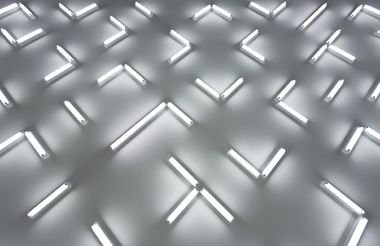Robert Irwin
dal 15/9/2008 al 18/10/2008
Segnalato da
15/9/2008
Robert Irwin
White Cube Mason's Yard, London
Light and Space. For this exhibition the artist has created 2 new installations. On the ground floor, Black features a series of floor-to-ceiling parallel scrim material panels, which the viewer must navigate, thereby altering the perceptual field of the space. In addition, Irwin has made subtle adjustments to the optical conditions of the room, as a means of altering the phenomenological experience of the work.

White Cube Mason's Yard is pleased to present Robert Irwin's first solo exhibition
in the UK. Irwin has been one of the most influential artists working in the US over
the past five decades. A pioneer of the 'Light and Space' movement of the 1960s,
Irwin's work focuses on perceptual phenomena, such as light, volume and scale, with
installations that are conditioned by the site in which they take place.
Robert Irwin's career began as a painter before he started making objects, such as
discs and acrylic columns. The presentation and placement of these works became as
critical as the object itself, and in developing these ideas, Irwin sought to
dissolve the distinction between the edge of the sculpture and its environment. By
1970, this investigation had led Irwin to abandon traditional object-based studio
practice altogether. Instead he began to accept invitations to create new work by
responding to specific situations. Irwin has said: 'An exhibition for me is not a
statement but an experiment'. With this approach, which has enabled the artist to
also incorporate landscape design and architecture in his practice, Irwin has
produced some of the most extraordinary site-specific installations of recent
decades, including exhibitions at the Museum of Modern Art, the Whitney Museum, Dia
Center for the Arts, New York, the Getty Center, Los Angeles and Los Angeles County
Museum of Art.
For his exhibition at White Cube Mason's Yard, Irwin has created two new
installations. On the ground floor, 'Black³' features a series of floor-to-ceiling
parallel scrim material panels, which the viewer must navigate, thereby altering the
perceptual field of the space. In addition, Irwin has made subtle adjustments to the
optical conditions of the room, as a means of altering the phenomenological
experience of the work. Positioned on the west and east walls are two square
lacquered black paintings, echoes of which reverberate through the space,
transmitted on and through the perpendicular translucent screens.
In 'Light and Space II', located in the basement gallery, Irwin has created an
installation with hundreds of fluorescent lights mounted at right angles in a
non-repeating, grid-like formation. With no fixed focal point, the enveloping visual
field resonates with geometric patterns, drawn by luminous lines, which redefine the
characteristics of the space. 'Light and Space II' brings together, in a large-scale
but concise installation, the three principle points of reference throughout Irwin's
career: light, architecture and space.
Robert Irwin was born in Long Beach, California in 1928; he lives and works in San
Diego. He has exhibited widely internationally, including solo exhibitions at the
Museum of Contemporary Art San Diego (2007), Chinati Foundation, Marfa, Texas
(2006), Dia Center for the Arts, New York (2000), Museum of Contemporary Art, Los
Angeles (1993) and Musée d'Art Contemporain de Lyon, France. In 1984 he was the
first recipient of the MacArthur ('Genius Award') Fellowship. Among his numerous
public projects, the most recent is the architectural design and grounds for the Dia
Art Foundation's museum, Dia: Beacon in Beacon, New York and the Central Gardens of
the J Paul Getty Center in Los Angeles. He is currently working on a primordial palm
garden for the Los Angeles County Museum of Art.
Preview Tuesday 16 September 2008, 6-8pm
White Cube Mason's Yard
25-26 Mason's Yard 44 - London
Open Tuesday to Saturday, 10am to 6pm.
Free admission



